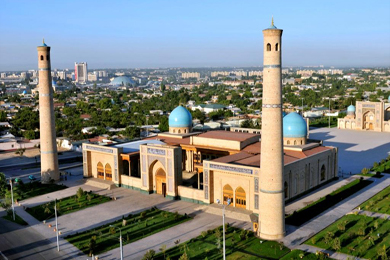Hazret Imam complex (15th century). Gives fuller picture about the developed architectural forms of medieval Tashkent. The ensemble developed on a grave of one of the first imams of Tashkent, the famous scientist, expert on the Koran and hadis Hazreti Imam (his full name - Abubekr Mahomed Kaffal of Shashi). By name the sheikh all area in this part of the old city received the name Hazreti Imam.
HAZRATI'S MAUSOLEUM OF THE IMAM
The seventh century of our era was marked in the history of mankind by a century of the Arab invasions and distribution of Islam in the world. The Arab caliphate inspired by large victories periodically interfered also in the Byzantine Empire. The Arab-Byzantine soldiers stormed not only on fields of battles, but also on diplomatic fields. For this purpose the Arab Caliphs needed the skilled, intelligent diplomat who is skillfully knowing several languages and able to notice thinly and sharply weaknesses of the enemy. So at court of the Arab Caliphs – Abbasidov – appeared Abu Bakr of ash-Shoshiya.
The full name of this person was Abu Bakr ibn Ali Ismoil Kaffal of ash-Shoshiya. He was born in 903 in Tashkent, in family of the manufacturer of locks. From here its nickname "kaffal" - "zamochnik". Young Abu Bakr, without wishing to become the ordinary handicraftsman, goes to study fiqh (a standard and legal part of Sharia), and together with it and other sciences, at first in madrasah of Tashkent, Samarkand, Khurasan, and then and to the capital of the Arab caliphate and the center of science of the Muslim world – Baghdad where he also carries out the most part of the life.
Being a diplomat at court of the Caliph, Abu Bakr Kaffal Shashy was not ecclesiastic at all. He was a poet, the scientist and the diplomat. Documents which it made for correspondence with the Byzantine emperor remained. His caustic and witty words to the emperor Nikifor II very much were pleasant to governors of the caliphate therefore in Baghdad he was famous as "Great Tashkentets" - "Shoshy Al Kabir".
The case when the Byzantine emperor Nikifor II ordered to write the spiteful letter to the Caliph poetically what Shoshy Al Kabir answered it with the witty poem from 74 lines written by the same meter, the stanza and a rhyme what Nikifor II had is known. (It is interesting to note that 7 centuries later similar correspondence will take place between the Zaporizhia Cossacks and the Turkish sultan which the artist Ilya Repin will skillfully reflect in the well-known cloth).
Except verses also the works on philosophy ("Beauty of dialectics") and the Islamic right ("Makhasin Shariat") written by Al Kabir, to this day having great success are known.
At the end of life the well-known tashkentets with honor returns home. But quietly the become frequent attacks of Turkic peoples-karakhanidov on east territories of the Arab caliphate do not allow to come to a noble old age in native Shashe to it. Situation aggravated also that the tribes of Karakhanidov were not Muslims. Al Kabir should show the diplomatic skill again and to convince governors Karakhanidov to accept Islam and to incline them to peace board. In this regard the city elite calls his "Hazrati Yim" ("the Saint Imam") and the Patron Saint of Tashkent.




